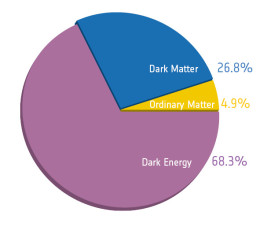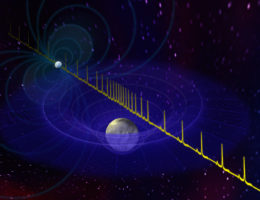The Earth, your body, and the electronic device you’re reading this on are all made up of ordinary, baryonic matter. A new study has now used bursts of radio emission to probe whether the outskirts of our galaxy are hiding vast quantities of “missing” baryonic matter.
Missing Matter

The relative amounts of the different constituents of the universe. Ordinary baryonic matter makes up less than 5%. [ESA/Planck]
Our own Milky Way is no exception — it also has a baryon fraction much lower than the overall baryon fraction in the universe. So where are its missing baryons? Were they expelled from our galaxy at some point in the past? Or did the Milky Way retain its baryons — but we haven’t detected them yet?
An Elusive Halo
If our galaxy’s baryons are still around, a likely hiding place is in the Milky Way’s outskirts, in the circumgalactic medium (CGM).

The Sombrero galaxy, M104, provides an example of a galaxy and its halo — the diffuse gas that extends above and below the galaxy’s disk. [ESA/C. Carreau]
A new study led by Emma Platts (University of Cape Town, South Africa) has instead measured the galactic halo’s matter by observing how distant signals interact with the CGM as they travel to us.
Clues from Transients
Platts and collaborators use two types of radio transients to measure CGM distribution: pulsars, which are pulsating neutron stars that reside in our galaxy’s disk, and fast radio bursts, which are brief flashes of radio emission that originate far beyond our galaxy.

Pulsars, which typically lie in the galactic disk, emit radiation that sweeps over the Earth like a lighthouse, appearing as pulses. These pulses become dispersed as they travel through the galaxy to reach us. [Bill Saxton/NRAO/AUI/NSF]
Probing Our Surroundings
By statistically analyzing the distribution of pulsar and fast radio burst dispersion measures, Platts and collaborators placed bounds on the Milky Way halo’s dispersion measure: its minimum is set by the farthest pulsars, which lie interior to the halo, and its maximum is set by the closest fast radio bursts, which lie far beyond our halo in neighboring galaxies.
So are the Milky Way’s missing baryons hiding in the CGM? We can’t say for certain yet, but the results suggest no, if the baryons are distributed in the same way as the dark matter. The future should hold more certainty though! Our sample of fast radio bursts is rapidly growing, and the authors estimate that once we’ve cataloged several thousand, we’ll be able to bound the content of the Milky Way’s halo more definitively.

Schematic illustrating how transient radio signals travel to us. Pulsars (marked by sun symbols) lie in the galaxy, interior to the halo; their signals are dispersed only by the Milky Way’s interstellar matter. Fast radio bursts (marked by lightning symbol) lie in other galaxies; their signals are dispersed by the Milky Way’s interstellar matter, its halo, the intergalactic medium, the host galaxy’s halo, and the host itself. These two types of transients can therefore place upper and lower bounds on the matter in the Milky Way’s halo. [Platts et al. 2020]
Citation
“A Data-driven Technique Using Millisecond Transients to Measure the Milky Way Halo,” E. Platts et al 2020 ApJL 895 L49. doi:10.3847/2041-8213/ab930a

5 Comments
Pingback: From AAS NOVA: “Will Radio Bursts Reveal Hidden Baryons?” | sciencesprings
Pingback: Will Radio Bursts Reveal Hidden Baryons? – Sky & Telescope – Ten15AM
Pingback: Will Radio Bursts Reveal Hidden Baryons? – Sky & Telescope | Space Force
Pingback: Will Radio Bursts Reveal Hidden Baryons? - Sky & Telescope - Worldika - New Platform For Explore World
Pingback: Will Radio Bursts Reveal Hidden Baryons? – Storm-Tech Nomad